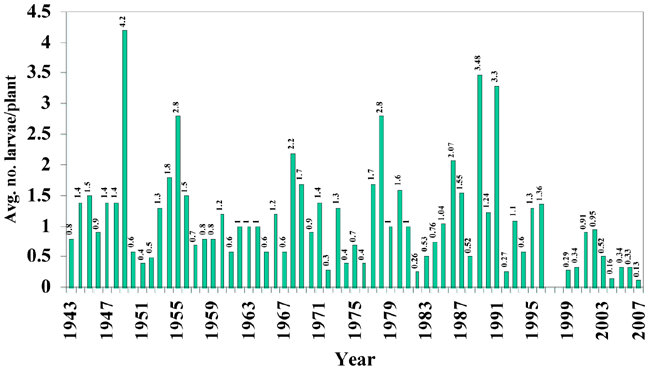Urbana, Illinois
November 8, 2007
University
of Illinois Extension
The
Bulletin No. 24 Article 3/November 9, 2007
Our annual survey for second-generation European corn borers was
completed relatively recently by University of Illinois Extension
educators, county-based Extension personnel, and Department of Crop
Sciences staff and graduate students. We are not certain how much longer
we will conduct this historic survey (primarily because of constraints
on time and human resources), but through 2007 we were able to include
it on our annual list of things to do. We thank everyone who volunteered
for this annual effort, which continues to add data to our ever-growing
database.
After making something of a comeback in some regions of Illinois during
the fall of 2006, second-generation European corn borers apparently
encountered a hostile environment during the late summer and fall of
2007. Widespread planting of transgenic Bt corn with traits for control
of corn borers was probably the primary component of the hostile
environment in 2007. According to
estimates published by the USDA Economic Research Service, acres of
Bt corn in the United States increased from 19% in 2001 to 49% in 2007.
Corn with stacked genes (Bt plus herbicide resistance) increased
significantly in Illinois from 2000 to 2007. It is possible that the
corn borer-resistant Bt corn hybrids are suppressing corn borer
populations over large areas. The trend for lower population densities
of European corn borers has been observed in several other Midwestern
states.
Results from the 2007 survey of second-generation European corn borer
larvae in Illinois are presented in Table 1. We will prepare a
PowerPoint slide set with these data in the near future and post it to
the University of Illinois
IPM Web site on the European corn borer "home page."

Population densities (numbers of borers per 100 plants) declined
noticeably in most counties and Crop Reporting Districts from
2006 to 2007. Average densities of corn borer larvae in the nine
Crop Reporting Districts ranged from 2.8 larvae per 100 plants
in the East to 57 in the West Southwest. The largest average of
120.6 borers per 100 plants was observed in Madison County (West
Southwest). No European corn borer larvae were found in any of
the 10 fields surveyed in each of six countiesMacon, McLean,
Iroquois, Clark, Lawrence, and Jackson. On the other extreme,
one field in Calhoun County had an average of 300 corn borers
per 100 plants, one in Madison County had an average of 484, and
one in Montgomery County had an average of 450. So apparently
the environment in the West Southwest Crop Reporting District
was suitable for survival of European corn borers . . . as long
as the corn was not Bt corn.
The mean percentages of corn plants infested with European corn
borer larvae ranged from 1.9% in the East to 28.6% in the West
Southwest. The highest average percentage infestation (50.4%)
occurred in Greene County. The data in many counties revealed an
all-or-nothing fluctuation in corn borer densities. In other
words, there were no corn borers in most of the fields within a
given county, with one, two, or, at most, five fields with
relatively significant infestations of larvae (60% to an
occasional 100% infestation).
The statewide average density of second-generation European corn
borers in Illinois in 2007 was 13.4 larvae per 100 plants, the
lowest density we have ever determined from these annual
surveys, which began in 1943 (Figure 1). The next-lowest density
(about 16 borers per 100 plants) determined from these surveys
occurred in 2004. In the 63 years that the survey has been
conducted (it was not conducted in 1997 and 1998), the average
density of corn borers has been less than 0.35 larva per plant
in 9 years . . . six times during the past 9 years, including
the past 4 four years. These data suggest that Bt corn has
become a major mortality factor in populations of European corn
borers.

Data from the annual survey of second-generation European corn
borers usually cannot be used to predict infestations of
European corn borers throughout the following year. However, we
know that if the population in the fall is relatively small, the
potential population of first-generation European corn borers
the following spring usually is small. Unfortunately, we have
not been able to determine the impact of two disease organisms
that infect European corn borer larvaeBeauveria bassiana (a
fungus) and Nosema pyrausta (a microsporidian)over the past few
years.
As we increase the acres of corn in Illinois to meet the demands
for food, feed, and fuel, the habitat available for European
corn borers will increase. However, if the potential habitat is
populated primarily with Bt corn with borer-control traits, the
mortality of European corn borers should continue to be
significant. This latter point actually underscores the need for
corn producers to comply with the insect resistance management
strategies that require 20% non-Bt corn. Without these refuges,
the population selection pressure will be intense, increasing
the potential for European corn borer populations to develop
resistance to Bt proteins.
The European corn borer is not an endangered species, but its
populations certainly have taken some serious hits over the past
several years.
by
Kevin Steffey and
Mike Gray |
|